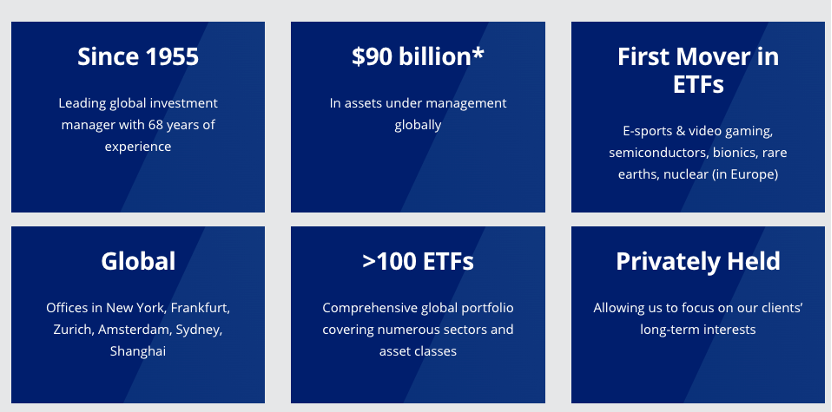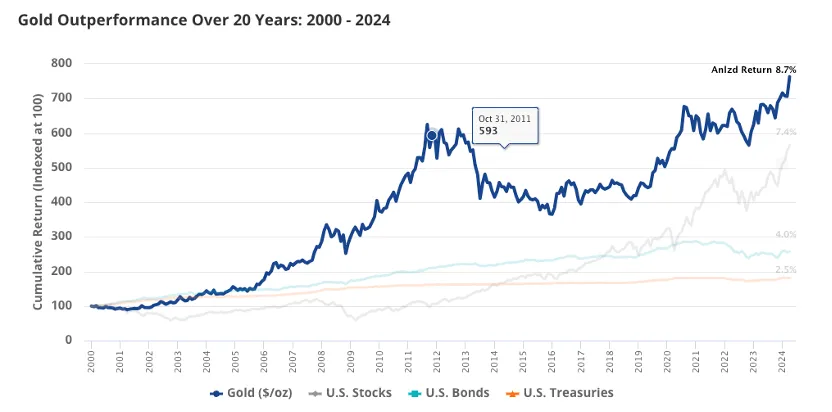From Gold ETFs to Solana ETFs: The Rise of VanEck
VanEck, an investment company specializing in ETFs, has a history marked by bold innovation and strategic decisions. From launching a gold ETF to recently applying for a Solana ETF, VanEck has continually pushed boundaries, driving change in financial markets.
As the cryptocurrency market rapidly evolves, VanEck is at the forefront, pioneering new investment opportunities with the Solana ETF application.
VanEck’s History
In 1955, John van Eck founded Van Eck Global to capitalize on the growing international stock market, aiming to offer post-WWII investment opportunities to American investors. The same year, Van Eck launched its first international equity mutual fund.
In 1968, VanEck introduced the International Investors Gold Fund, one of America’s first gold funds, shifting most of its portfolio to gold mining stocks. The gold bull market from the 1970s to mid-1980s led to significant success, with the fund managing over $1 billion in assets. John van Eck gained notable recognition, appearing on popular talk shows like “Wall Street Week” and “The Merv Griffin Show.”
The Downturn (1980s to Early 2000s)
The mid-1980s marked the end of the gold market boom, and VanEck’s business slowed down. By 1998, the International Investors Gold Fund’s assets dwindled to $250 million. To counter the downturn, the company ventured into emerging Asian markets in the 1990s, signing a joint venture agreement with Shenyin & Wanguo (now Shenwan Hongyuan) to tap into China’s fund market.
However, the 1997 Asian financial crisis sharply reduced demand for emerging market funds, causing significant asset reductions for VanEck’s Asia Dynasty Fund.
From 1994 to 1998, VanEck’s managed assets fell by 21%, from $1.82 billion to $1.44 billion. Metal prices hit a 12-year low in 1997, and only the Global Hard Assets Fund posted positive returns during this period.
The ETF Shift (Post-2006)
In 2006, VanEck entered the ETF business with its first product, the Market Vectors Gold Miners ETF, enabling investors to trade gold through the stock market. Despite not matching the popularity of SPDR Gold Shares, launched in 2004, it grew to manage $5 billion in assets, becoming one of VanEck’s major successes. By November 2009, VanEck had over 20 ETF products, managing $9.7 billion in assets.
John van Eck’s frequent travels and marriage to Sigrid, a German woman he met in Europe, brought a personal touch to the company’s story. In the early 1990s, his sons Derek and Jan joined the company, driving a focus on ETFs that led to significant growth.
After Derek’s death in 2010, Jan has managed the expanding global business. Jan, inspired by tech entrepreneurs and holding a law degree from Stanford, shifted the company’s focus towards ETFs.
VanEck opened its first European office in 2008, followed by a Swiss office in 2010, focusing on index business and alternative investment strategies. In 2018, VanEck acquired Dutch ETF provider “Think ETF Asset Management B.V.,” expanding its ETF offerings in Europe and globally.
On March 2, 2021, VanEck launched the Vectors Social Sentiment ETF (BUZZ) on NYSE Arca, which saw $280 million inflows on its first day, making it one of the best debuts in history.
Today, VanEck has issued over 100 ETFs, managing more than $90 billion in assets.

Gold ETFs and VanEck
Gold ETFs are financial products that track the price of gold, allowing investors to buy and sell shares of gold through the stock exchange without the need to physically hold the metal. The emergence of gold ETFs significantly simplified the process of investing in gold, reducing both transaction costs and risks.
The first gold exchange-traded product was the Central Fund of Canada, a closed-end fund established in 1961. In 1983, it amended its corporate charter to offer investors a product that held physical gold and silver.
In 1968, VanEck launched the first open-ended gold stock mutual fund in the United States.
In 1971, U.S. President Nixon ended the gold standard. VanEck’s gold fund (now known as the VanEck International Investors Gold Fund) was the first of its kind, and as gold prices soared from $35 to $800 per ounce, the fund became the best performer in its category.

Despite John van Eck’s passion for gold, his son Jan van Eck recognized the vulnerability of relying too heavily on it. He shifted the company’s focus to ETFs, which now account for 90% of VanEck’s business.
On March 28, 2003, the first gold ETF developed by ETF Securities was listed on the Australian Stock Exchange. On November 18, 2004, State Street Corporation launched SPDR Gold Shares in the U.S., which saw its assets surpass $1 billion within its first three trading days.
In 2006, VanEck launched its first gold ETF, the Market Vectors Gold Miners ETF, just two years after the first U.S. gold ETF. Today, this ETF has an average trading volume of around $20 million and manages assets totaling $13.2 billion.
VanEck in the Crypto World
First Bitcoin Futures ETF, First Spot Ethereum ETF, First Solana ETF
VanEck has been a key player in the Bitcoin and Ethereum ETF space. Unlike BlackRock’s high approval rate, VanEck has been characterized by its “first-to-file, bold experimentation” approach. On August 11, 2017, VanEck submitted an S-1 application to launch the first Bitcoin Futures ETF, becoming the first to file for an ETF investing in Bitcoin futures. Subsequently, VanEck continuously applied for a spot Bitcoin ETF.
However, in November 2021, the SEC rejected the application, citing concerns that potential fraud in the crypto market could extend to regulated exchanges. From 2021 to March 2023, VanEck’s applications were rejected three times. Nevertheless, VanEck persisted and finally succeeded during the wave of spot Bitcoin ETF approvals in 2024.
Following this, VanEck became the first company to file for a spot Ethereum ETF in 2021, nearly three years before the SEC began engaging with issuers like BlackRock, Fidelity, and Ark Invest.
Unlike companies such as Fidelity and BlackRock that focus solely on Bitcoin and Ethereum ETFs (with BlackRock’s Head of Digital Assets, Robert Mitchnick, publicly stating that BlackRock believes clients have “little interest” in cryptocurrencies other than Bitcoin and Ethereum), VanEck took an additional step by applying for a Solana ETF.
At the end of June, VanEck filed an application for a spot Solana ETF with the SEC, becoming the first issuer to do so. In a post on platform X, VanEck’s Head of Digital Asset Research, Matthew Sigel, stated, “The decentralized nature, high utility, and economic viability of SOL align with the characteristics of established digital commodities, reinforcing our belief that SOL could be a valuable commodity with uses for investors, developers, and entrepreneurs seeking alternatives to duopoly app stores.”
VanEck is known for its pioneering position in the digital assets field.
Coindesk remarked
Conclusion
VanEck’s history of innovation and strategic decisions, from gold ETFs to Solana ETFs, highlights its role as a leader in the evolving financial markets. Its commitment to pioneering new investment opportunities continues to shape the future of both traditional and digital asset investing.